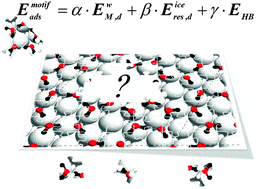A unified study for water adsorption on metals: meaningful models from structural motifs
The adsorption of the first water layer on metals combines several structural motifs like pentagons, hexagons, and heptagons interconnected variably leading to a myriad of patterns. Although theoretical methods are now able to discriminate the ground states, there is a need to find simple ways to account for the relative stability of different patterns on the surface. Taking the already reported structures for water bilayers as training sets we have decomposed the adsorption energy of each of the motifs to their fundamental components: water–water and water–metal interactions through strain-induced surface metal deformations. Models coming from this scheme can be used to survey the properties of many of the structures reported irrespectively of their complexity, thus providing a simple structure-based tool to assess the likeliness, relative stability, wettability, and main patterns of water motifs in metals.

G. Revilla-López, N. López
Phys. Chem. Chem. Phys. 2014, 16, 18933-18940
DOI:
Go to the journal

Let's create a brighter future
Join our team to work with renowned researchers, tackle groundbreaking
projects and contribute to meaningful scientific advancements



















